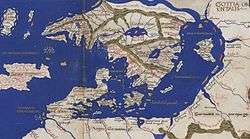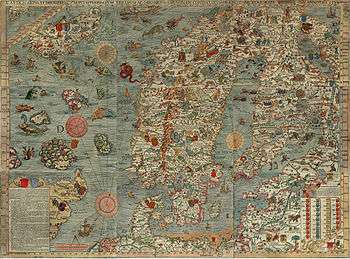Scandza
The Gothic-Byzantine historian Jordanes described Scandza as a "great island" in his work Getica, written in Constantinople around 551 AD. This island was located in the Arctic regions of the sea that surrounded the world.[1] He discussed the area in the opening of his Getica, which gives a story of the history of the Goths, beginning in Scandza, after which they migrated to Gothiscandza, near the mouth of the Vistula river.
It is believed that Jordanes was describing Scandinavia. Prominent Swedish archaeologist, Göran Burenhult, regards Jordanes' account as a unique glimpse into the tribes of Scandinavia in the 6th century.[2]
Jordanes was a Roman citizen living in Constantinople but he described himself as being of Gothic descent.
Geographical description through history

Early Greek and Roman geographers used the name Scandia for various uncharted islands in Northern Europe. The name originated in Greek sources, which used it for a long time for different islands in the Mediterranean region.[3] In the Iliad the name denotes an ancient city in Kythira, Greece.[4] The first attested written use of the name for a Northern European island appears in the work of Roman Pliny the Elder, Naturalis Historia of c. AD 77.[5] Pliny described "Scandia" as an island located north of Britannia.[6] This island does not appear to be the same as the island Pliny calls "Scatinavia", located near Cimbri. In Claudius Ptolemy's Geographia, written in the 2nd century AD, Scandia is described as the most easterly of the Scandiae islands, a group of islands located east of the Cimbrian peninsula.[7] This is the region where Pliny had located "Scatinavia".
When Scandinavian scholars became familiar with the Roman records in the Middle Ages, Scandiae was used as an alternative Latin name for Terra Scania. The early 13th-century Latin paraphrase of the Scanian Law bears the title Lex Scandiae provincialis.[8]

Jordanes referred to Ptolemy's description of Scandia "as a great island shaped like a juniper leaf" (i.e. long and not round) "having bulging sides and which tapered down in the south at a long end".[1] He also referred to Pomponius Mela's description of Codanonia (called Scatinavia by Pliny the Elder) which was located in the Codanian Gulf (probably Kattegat). "This island was in front of the Vistula and that there was a great lake" "from which sprang the river Vagus". "On the western and northern side it was surrounded by an enormous sea", "but in the east there was a land bridge which cut off the sea in the east forming the German Sea". "There were also many small islands" (the Swedish and Finnish archipelagos) "where wolves could pass when the sea was frozen. In winter the country was not only cruel to people but also to wild beasts. Due to the extreme cold there were no swarms of honey-making bees."
In the 16th century, Olaus Magnus, a Swedish cartographer familiar with Pliny's writings, created a map where he placed the name "Scandia" in the middle of today's Sweden. In Olaus Magnus' map, the name denotes an area including "Svecia" (Svealand), "Gothia" and "Norvegia" (Norway), where he places various tribes described by the ancient geographers.
Although mainly a historical name, Scandia still occasionally continues in use today as a Latin name for Scandinavia. The Scandinavian Bishops Conference, an Episcopal Conference organized by the Catholic Church since 1923, is called Conferentia Episcopalis Scandiae.
Midsummer sun and the midwinter darkness
In the north, there was the nation of the Adogit (perhaps referring to the inhabitants of Hålogaland in Norway or the people of Andøya[9]) who lived in continual light during the midsummer (for forty days and nights) and in continual darkness (for as long) during the midwinter. Due to this alternation they go from joy to suffering (the first description of the Scandinavian winter depression). The sun moreover seemed to pass along the horizon rather than rise from below.
Inhabitants
Jordanes names a multitude of tribes living in Scandza, which he named a womb of nations (loosely translated), and says they were taller and more ferocious than the Germans (archaeological evidence has shown the Scandinavians of the time were tall, probably due to their diet). The listing represents several instances of the same people named twice, which was probably due to the gathering of information from diverse travellers[10] and from Scandinavians arriving to join the Goths, such as Rodwulf from Bohuslän.[11] Whereas linguists have been able to connect some names to regions in Scandinavia, there are others that may be based on misunderstandings.[2]
On the island there were the Screrefennae (i.e. Sami peoples[9]) who lived as hunter-gatherers living on a multitude of game in the swamps and on birds' eggs.
There were also the Suehans (Swedes) who had splendid horses like the Thuringians (Snorri Sturluson wrote that the 6th-century Swedish king Adils had the best horses of his time). They were the suppliers of black fox skins for the Roman market and they were richly dressed even though they lived in poverty.
There were also the Theustes (the people of the Tjust region in Småland), Vagoths (probably the Gutes of Gotland[12]), Bergio (either the people of Bjäre Hundred in Skåne, according to L Weibull, or the people of Kolmården according to others), Hallin (southern Halland) and the Liothida (either the Luggude Hundred or Lödde in Skåne, but others connect them to Södermanland[13]) who live in a flat and fertile region, due to which they are subject to the attacks of their neighbours. Other tribes were the Ahelmil (identified with the region of Halmstad[14]), the Finnaithae (Finnhaith-, i.e. Finnheden, the old name for Finnveden), the Fervir (the inhabitants of Fjäre Hundred) and the Gautigoths (the Geats of Västergötland), a nation which was bold and quick to engage in war. There were also the Mixi, Evagreotingis (or the Evagres and the Otingis depending on the translator), who live like animals among the rocks (probably the numerous hillforts and Evagreotingis is believed to have meant the "people of the island hill forts" which best fits the people of Bohuslän[15]). Beyond them, there were the Ostrogoths (Östergötland), Raumarici (Romerike), the Ragnaricii (probably Ranrike, an old name for a part of Bohuslän) and the most gentle Finns (probably the second mention of the Sami peoples[16] mixed for no reason). The Vinoviloth (possibly remaining Lombards, vinili[17]) were similar.
He also named the Suetidi (a second mention of the Swedes[16]). The Dani were of the same stock and drove the Heruls from their lands. Those tribes were the tallest of men.
In the same area there were the Granni (Grenland[18]), Augandzi (Agder[18]), Eunixi, Taetel, Rugii (Rogaland[18]), Arochi (Hordaland[18]) and Ranii (possibly the people of Romsdalen[18]). The king Rodulf was of the Ranii but left his kingdom and joined Theodoric, king of the Goths.
See also
Notes
- Jordanes. The origin and deeds of the Goths.
- Burenhult 1996:94
- Rubekeil, Ludwig (2002). "Scandinavia in the light of ancient tradition". In The Nordic Languages: an international handbook of the history of the North Germanic languages. Eds. Oskar Bandle et al., Vol I. Berlin and New York: de Gruyter, 2002. ISBN 3-11-014876-5, p. 601.
- Blackie, John Stuart (1866). Homer and the Iliad. Notes, Philological and Archaeological. Edmonston and Douglas, 1866. Digitized 30 August 2006.
- Helle, Knut (2003). "Introduction". The Cambridge History of Scandinavia. Ed. E. I. Kouri et al. Cambridge University Press, 2003. ISBN 0-521-47299-7.
- Chapter 30. (16.)- BRITANNIA.. The Natural History. Pliny the Elder. John Bostock. Taylor and Francis, 1855.
- Ptolomy, Book II, Chapter 10: Greater Germany (Fourth Map of Europe); interpreted by Bill Thayer.
- Herzog, Johann Jakob et al. (1896). Realencyklopädie für protestantische Theologie und Kirche. J. C. Hinrichs Theology, published 1896. Digitized 15 November 2006.
- Nerman 1925:36
- Nerman 1925:46
- Ohlmarks 1994:255
- Nerman 1925:40
- Nerman 1925:38
- Ohlmarks 1994:10
- Nerman 1925:42ff
- Nerman 1925:44
- See Christie, Neil. The Lombards: The Ancient Longobards (The Peoples of Europe Series). ISBN 978-0-631-21197-6.
- Nerman 1925:45
Sources
- Jūratė Statkutė de Rosales (2004) Balts and Goths: the missing link in European history, translation by Danutė Rosales; supervised and corrected by Ed Tarvyd. Lemont, Ill. : Vydūnas Youth Fund.
- Burenhult, Göran (1996) Människans historia, VI.
- Nerman, B. Det svenska rikets uppkomst. Stockholm, 1925.
- Ohlmarks, Å. (1994). Fornnordiskt lexikon
- Ståhl, Harry (1970) Ortnamn och ortnamnsforskning, AWE/Gebers, Uppsala.